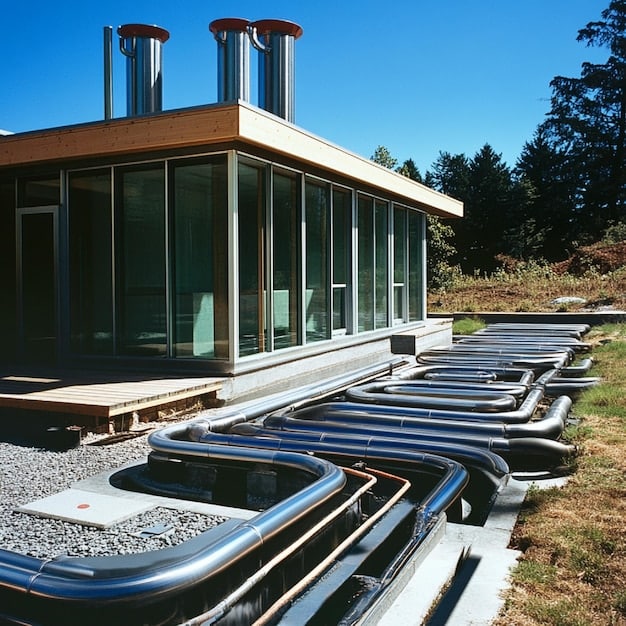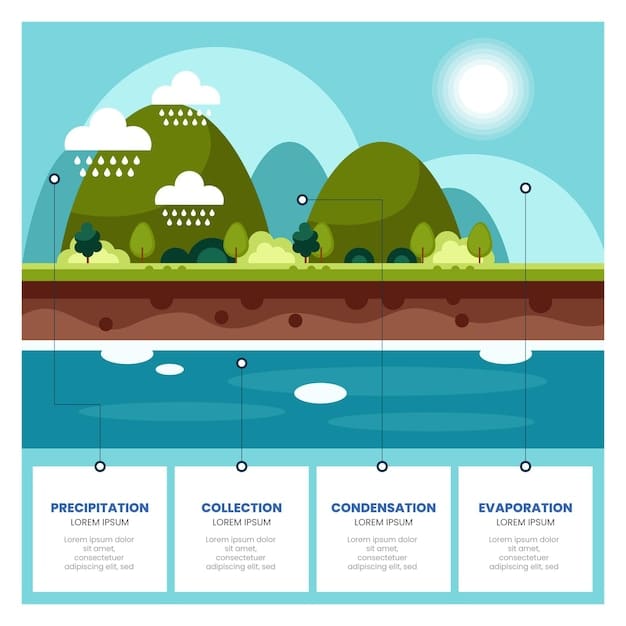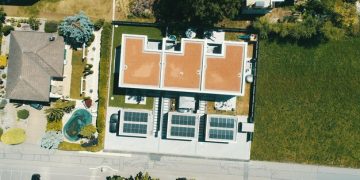Geothermal Heating Systems: A Deep Dive into Energy Savings

Unlocking energy savings through geothermal heating systems involves harnessing the Earth’s natural heat to provide efficient, sustainable, and cost-effective heating and cooling solutions for residential and commercial buildings.
Are you looking for a sustainable and cost-effective way to heat and cool your home? Unlocking energy savings with geothermal heating systems might be the solution you’ve been searching for.
Understanding Geothermal Heating Systems
Geothermal heating systems offer a unique approach to temperature control by tapping into the Earth’s stable underground temperatures. This technology can significantly reduce your energy consumption and environmental impact.
Let’s explore the fundamental principles, components, and types of geothermal systems to understand how they work and their potential benefits.
The Science Behind Geothermal Energy
Geothermal energy utilizes the consistent temperature found a few feet below the Earth’s surface. This temperature, typically between 45°F and 75°F (7°C and 24°C), remains relatively constant year-round, regardless of seasonal changes. Geothermal systems leverage this stable temperature to heat and cool buildings efficiently.
Key Components of a Geothermal System
A geothermal system consists of three main components: a ground loop, a heat pump, and a distribution system. The ground loop, made of underground pipes, circulates a heat-transfer fluid. The heat pump transfers heat between the ground loop and the building. The distribution system, like ductwork or radiant floor heating, delivers the heated or cooled air/water throughout the building.

- Ground Loop: Buried pipes that circulate a heat-transfer fluid.
- Heat Pump: Transfers heat between the ground and the building.
- Distribution System: Delivers heated or cooled air/water throughout the building.
In essence, geothermal systems act as a heat exchanger, moving heat into your home during the winter and out of your home during the summer, all while using a fraction of the energy required by traditional heating and cooling methods.
Types of Geothermal Systems
There are several types of geothermal systems, each designed to suit different site conditions and heating/cooling needs. The primary types are closed-loop and open-loop systems, each with its advantages and disadvantages.
Choosing the right system depends on factors such as land availability, soil type, and access to a suitable water source.
Closed-Loop Systems
Closed-loop systems circulate a heat-transfer fluid through a sealed network of underground pipes. These systems can be horizontal, vertical, or pond/lake loops. Horizontal loops are cost-effective and ideal for properties with ample land, while vertical loops are suitable for smaller properties. Pond/lake loops utilize a nearby body of water for heat exchange.
Open-Loop Systems
Open-loop systems, also known as direct exchange systems, use well or surface water as the heat-transfer fluid. Water is drawn from a well or body of water, circulated through the heat pump, and then discharged back into the environment. Open-loop systems are highly efficient but require a reliable water source and may be subject to local regulations.
- Horizontal Loops: Cost-effective for properties with ample land.
- Vertical Loops: Suitable for smaller properties.
- Pond/Lake Loops: Utilize a nearby body of water.
Understanding these different types of geothermal systems allows you to select the most appropriate option for your specific needs and environmental conditions.
The Benefits of Geothermal Heating
Geothermal heating offers a multitude of benefits that extend beyond energy savings. From environmental advantages to long-term cost reductions, geothermal systems provide a compelling alternative to traditional heating and cooling methods.
Let’s explore some of the most significant advantages of investing in a geothermal heating system.

Energy Efficiency and Cost Savings
Geothermal systems are significantly more energy-efficient than traditional HVAC systems. They can reduce energy consumption by 25% to 50%, resulting in substantial cost savings on your utility bills. The initial investment may be higher, but the long-term savings make geothermal systems a cost-effective choice.
Environmental Impact
Geothermal heating is an environmentally friendly technology that reduces your carbon footprint. By utilizing the Earth’s natural heat, geothermal systems minimize greenhouse gas emissions and reliance on fossil fuels. This contributes to a cleaner and more sustainable environment.
Increased Comfort and Reliability
Geothermal systems provide consistent and even heating and cooling throughout your home. They operate quietly and require minimal maintenance, offering increased comfort and reliability compared to traditional HVAC systems. The stable underground temperatures ensure consistent performance, even during extreme weather conditions.
- Reduced Energy Consumption: Lower utility bills and energy dependence.
- Lower Carbon Footprint: Environmentally friendly and sustainable.
- Consistent Comfort: Even heating and cooling throughout the home.
Investing in geothermal heating not only enhances your comfort and reduces your energy costs but also supports a more sustainable future.
Installation and Maintenance
Proper installation and maintenance are crucial for the optimal performance and longevity of a geothermal heating system. The process involves several steps, from site assessment to system startup, and requires the expertise of trained professionals.
Understanding the installation process and maintenance requirements can help you ensure your system operates efficiently for years to come.
The Installation Process
The installation process typically begins with a site assessment to determine the best type of geothermal system for your property. This involves evaluating soil conditions, land availability, and heating/cooling requirements. Next, the ground loop is installed, followed by the heat pump and distribution system. A qualified technician must perform proper installation to ensure optimal performance.
Regular Maintenance
Geothermal systems require minimal maintenance compared to traditional HVAC systems. Regular maintenance includes checking the ground loop for leaks, cleaning the heat pump coils, and inspecting the distribution system. A professional inspection every few years can help identify and address any potential issues before they become major problems.
Finding Qualified Professionals
Hiring qualified professionals for both installation and maintenance is essential. Look for contractors with experience in geothermal systems and certifications from organizations such as the International Ground Source Heat Pump Association (IGSHPA). Proper installation and maintenance will ensure your system operates efficiently and reliably for many years.
- Professional Installation: Ensures optimal performance and efficiency.
- Regular Inspections: Identifies and addresses potential issues early.
- Certified Technicians: Guarantees expertise and quality workmanship.
By following these installation and maintenance guidelines, you can maximize the benefits of your geothermal heating system and enjoy years of reliable and efficient performance.
Cost Considerations and Incentives
While geothermal heating systems offer significant long-term benefits, it’s important to consider the initial investment and ongoing operational costs. Various incentives and rebates can help offset the initial expenses, making geothermal systems more accessible and affordable.
Let’s examine the cost factors and available incentives to make an informed decision about investing in geothermal heating.
Initial Investment
The initial investment for a geothermal system is typically higher than for a traditional HVAC system. This includes the cost of the ground loop installation, heat pump, and distribution system. However, the long-term energy savings and environmental benefits often outweigh the upfront costs.
Operational Costs
Geothermal systems have lower operational costs compared to traditional HVAC systems. They use significantly less energy to heat and cool your home, resulting in lower utility bills. The minimal maintenance requirements also contribute to reduced long-term expenses.
Available Incentives and Rebates
Numerous incentives and rebates are available at the federal, state, and local levels to encourage the adoption of geothermal heating systems. These incentives can include tax credits, grants, and rebates, which can significantly reduce the initial investment. Research available incentives in your area to maximize your savings.
- Tax Credits: Federal and state tax credits can reduce the overall cost.
- Grants: Government grants may be available to support installation.
- Rebates: Local utility companies often offer rebates for energy-efficient systems.
By understanding the cost considerations and taking advantage of available incentives, you can make geothermal heating a financially viable and environmentally responsible choice for your home.
Geothermal Heating: Is It Right for You?
Deciding whether geothermal heating is the right choice for your home involves evaluating several factors, including your location, property size, and heating/cooling needs. Assessing these factors can help you determine if geothermal energy is a practical and beneficial solution for your specific circumstances.
Let’s explore the key considerations to help you make an informed decision.
Assessing Your Location and Property
Your location and property size play a significant role in determining the feasibility of a geothermal system. Properties with ample land are well-suited for horizontal ground loops, while smaller properties may require vertical loops. Access to a reliable water source is essential for open-loop systems.
Evaluating Your Heating and Cooling Needs
Consider your heating and cooling needs when evaluating geothermal heating. Geothermal systems are effective in a wide range of climates, providing efficient temperature control year-round. Assess your current energy consumption and costs to estimate the potential savings with a geothermal system.
Considering Long-Term Benefits
Think beyond the initial investment and consider the long-term benefits of geothermal heating. The reduced energy costs, environmental advantages, and increased comfort make geothermal systems a compelling choice for homeowners seeking a sustainable and cost-effective heating and cooling solution.
- Land Availability: Determines the type of ground loop suitable for your property.
- Energy Consumption: Estimates potential savings with a geothermal system.
- Sustainability Goals: Aligns with environmentally responsible choices.
By carefully assessing these factors, you can determine whether geothermal heating is the right fit for your home and start unlocking energy savings and a more sustainable future.
| Key Point | Brief Description |
|---|---|
| 💡 Energy Efficiency | Geothermal systems use less energy than traditional HVAC, saving money. |
| 🌎 Environmental Impact | Reduces carbon footprint by using Earth’s natural heat. |
| 💰 Cost Savings | Lower utility bills and potential incentives make it cost-effective long-term. |
| 🛠️ Maintenance | Geothermal systems require minimal upkeep compared to traditional systems. |
Frequently Asked Questions
▼
Geothermal systems use the Earth’s consistent underground temperature to heat and cool buildings. They transfer heat from the ground to the building in winter and reverse the process in summer.
▼
The main types are closed-loop (horizontal, vertical, pond/lake) and open-loop systems. Closed-loop systems circulate fluid in a sealed network, while open-loop systems use well or surface water.
▼
Geothermal heating offers energy efficiency, reduced carbon footprint, consistent comfort, and long-term cost savings compared to traditional heating and cooling systems.
▼
The initial cost is higher than traditional systems, but incentives and long-term energy savings can offset the expense. Costs vary depending on system type and property specifics.
▼
Consider your location, property size, and heating/cooling needs. Geothermal systems are versatile but require adequate land or water access for optimal performance and energy savings.
Conclusion
By understanding the principles, benefits, and considerations of geothermal heating systems, you can make an informed decision about unlocking energy savings and creating a more sustainable future for your home. Geothermal technology offers a promising path towards energy efficiency and environmental responsibility.





